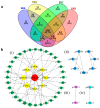Identification of Gene-Allele System Conferring Alkali-Tolerance at Seedling Stage in Northeast China Soybean Germplasm
- PMID: 38474209
- PMCID: PMC10931751
- DOI: 10.3390/ijms25052963
Identification of Gene-Allele System Conferring Alkali-Tolerance at Seedling Stage in Northeast China Soybean Germplasm
Abstract
Salinization of cultivated soils may result in either high salt levels or alkaline conditions, both of which stress crops and reduce performance. We sampled genotypes included in the Northeast China soybean germplasm population (NECSGP) to identify possible genes that affect tolerance to alkaline soil conditions. In this study, 361 soybean accessions collected in Northeast China were tested under 220 mM NaHCO3:Na2CO3 = 9:1 (pH = 9.8) to evaluate the alkali-tolerance (ATI) at the seedling stage in Mudanjiang, Heilongjiang, China. The restricted two-stage multi-locus model genome-wide association study (RTM-GWAS) with gene-allele sequences as markers (6503 GASMs) based on simplified genome resequencing (RAD-sequencing) was accomplished. From this analysis, 132 main effect candidate genes with 359 alleles and 35 Gene × Environment genes with 103 alleles were identified, explaining 90.93% and 2.80% of the seedling alkali-tolerance phenotypic variation, respectively. Genetic variability of ATI in NECSGP was observed primarily within subpopulations, especially in ecoregion B, from which 80% of ATI-tolerant accessions were screened out. The biological functions of 132 candidate genes were classified into eight functional categories (defense response, substance transport, regulation, metabolism-related, substance synthesis, biological process, plant development, and unknown function). From the ATI gene-allele system, six key genes-alleles were identified as starting points for further study on understanding the ATI gene network.
Keywords: Northeast China soybean germplasm population (NECSGP); alkali tolerance; gene function; gene–allele matrix; gene–allele sequence marker (GASM); optimal cross design; restricted two-stage multilocus genome-wide association study (RTM-GWAS); soybean (Glycine max (L.) Merr.).
Conflict of interest statement
The authors declare no conflicts of interest.
Figures


Similar articles
-
Gene-allele system of shade tolerance in southern China soybean germplasm revealed by genome-wide association study using gene-allele sequence as markers.Theor Appl Genet. 2023 Jun 13;136(7):152. doi: 10.1007/s00122-023-04390-2. Theor Appl Genet. 2023. PMID: 37310498 Review.
-
Analysis of QTL-allele system conferring drought tolerance at seedling stage in a nested association mapping population of soybean [Glycine max (L.) Merr.] using a novel GWAS procedure.Planta. 2018 Oct;248(4):947-962. doi: 10.1007/s00425-018-2952-4. Epub 2018 Jul 6. Planta. 2018. PMID: 29980855
-
An Improved Genome-Wide Association Procedure Explores Gene-Allele Constitutions and Evolutionary Drives of Growth Period Traits in the Global Soybean Germplasm Population.Int J Mol Sci. 2023 May 31;24(11):9570. doi: 10.3390/ijms24119570. Int J Mol Sci. 2023. PMID: 37298521 Free PMC article.
-
Comprehensive Identification of Drought Tolerance QTL-Allele and Candidate Gene Systems in Chinese Cultivated Soybean Population.Int J Mol Sci. 2020 Jul 8;21(14):4830. doi: 10.3390/ijms21144830. Int J Mol Sci. 2020. PMID: 32650485 Free PMC article.
-
Transgressive Potential Prediction and Optimal Cross Design of Seed Protein Content in the Northeast China Soybean Population Based on Full Exploration of the QTL-Allele System.Front Plant Sci. 2022 Jul 12;13:896549. doi: 10.3389/fpls.2022.896549. eCollection 2022. Front Plant Sci. 2022. PMID: 35903228 Free PMC article.
Cited by
-
Advances in Molecular Plant Sciences.Int J Mol Sci. 2024 Jun 10;25(12):6408. doi: 10.3390/ijms25126408. Int J Mol Sci. 2024. PMID: 38928115 Free PMC article.
-
Deciphering of Genomic Loci Associated with Alkaline Tolerance in Soybean [Glycine max (L.) Merr.] by Genome-Wide Association Study.Plants (Basel). 2025 Jan 24;14(3):357. doi: 10.3390/plants14030357. Plants (Basel). 2025. PMID: 39942919 Free PMC article.
References
-
- Vavilov N.I., Vavylov M.I., Dorofeev V.F. Origin and Geography of Cultivated Plants. Cambridge University Press; Cambridge, UK: 1992.
-
- Liu X., He J., Wang Y., Xing G., Li Y., Yang S., Zhao T., Gai J. Geographic differentiation and phylogeographic relationships among world soybean populations. Crop J. 2020;8:260–272. doi: 10.1016/j.cj.2019.09.010. - DOI
-
- Gizlice Z., Carter T., Jr., Burton J. Genetic base for North American public soybean cultivars released between 1947 and 1988. Crop Sci. 1994;34:1143–1151. doi: 10.2135/cropsci1994.0011183X003400050001x. - DOI
-
- Pitman M.G., Läuchli A. Salinity: Environment-Plants-Molecules. Springer; Dordrecht, The Netherlands: 2002. Global impact of salinity and agricultural ecosystems; pp. 3–20.
MeSH terms
Substances
Grants and funding
LinkOut - more resources
Full Text Sources

